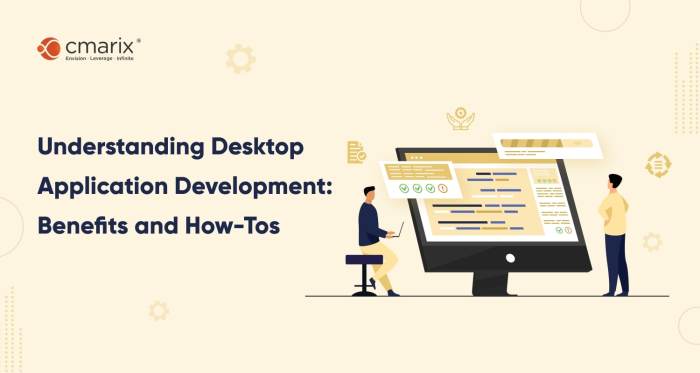Nearshore software development for desktop apps – The development of desktop applications has seen a significant shift in recent years, with businesses increasingly turning to nearshore software development as a cost-effective and efficient solution. This comprehensive guide delves into the intricacies of nearshore development for desktop apps, exploring its benefits, challenges, and best practices. We’ll cover various aspects, from choosing the right nearshore partner to managing the development process effectively.
Understanding Nearshore Software Development
Nearshore software development involves outsourcing software development projects to companies located in geographically proximate regions. Unlike offshore development, which often involves significant time zone differences and cultural barriers, nearshore outsourcing offers a closer proximity, facilitating easier communication and collaboration. This proximity often translates to reduced communication overhead and smoother project management. For desktop application development, this streamlined communication is crucial for addressing technical issues and ensuring timely project completion.

Source: zealousys.com
Benefits of Nearshore Desktop App Development, Nearshore software development for desktop apps
- Reduced Costs: While still offering cost savings compared to in-house development, nearshore development generally provides a more favorable cost structure than offshore options, particularly when considering factors like travel expenses and communication costs.
- Improved Communication: The reduced time zone differences and geographical proximity facilitate more efficient communication, leading to faster response times and quicker resolution of issues. This is particularly beneficial for complex desktop application projects requiring frequent interaction between the client and the development team.
- Cultural Compatibility: Nearshore partners often share similar cultural values and business practices, leading to smoother collaboration and fewer misunderstandings. This cultural alignment can significantly improve project management and team dynamics.
- Better Time Zone Alignment: Nearshore locations often operate within a similar time zone, allowing for overlapping work hours and facilitating real-time communication and collaboration.
- Easier Project Management: The proximity allows for more frequent in-person meetings and site visits, enhancing project visibility and facilitating better control over the development process. This direct access simplifies the management of complex desktop application projects.
- Access to Skilled Talent: Many nearshore locations boast a highly skilled workforce with expertise in various programming languages and technologies relevant to desktop application development, such as C++, C#, Java, and Python.
Choosing the Right Nearshore Partner for Desktop App Development
Selecting the right nearshore partner is critical to the success of your desktop application development project. Several key factors should be considered:
Key Considerations When Selecting a Nearshore Partner
- Technical Expertise: Assess the partner’s proficiency in the specific technologies required for your desktop application (e.g., .NET, Java, Electron, Qt). Review their portfolio and client testimonials to gauge their expertise.
- Communication and Collaboration: Evaluate their communication channels and responsiveness. Effective communication is crucial for a successful nearshore partnership. Look for evidence of clear communication protocols and dedicated project managers.
- Experience with Similar Projects: Choose a partner with a proven track record of successfully delivering similar desktop applications. Their experience will significantly reduce the risk of encountering unforeseen challenges.
- Security and Data Protection: Ensure the partner adheres to stringent security protocols and data protection regulations. This is particularly important when dealing with sensitive data within your desktop application.
- Project Management Methodology: Understand their project management approach (e.g., Agile, Waterfall). Choose a methodology that aligns with your project requirements and preferences.
- Legal and Contractual Aspects: Carefully review the contract to ensure it clearly Artikels responsibilities, intellectual property rights, payment terms, and dispute resolution mechanisms.
Technologies Used in Nearshore Desktop App Development
Nearshore development teams often leverage a variety of technologies for creating robust and efficient desktop applications. The choice of technology depends heavily on factors like the application’s requirements, target operating system, and budget constraints.
Popular Technologies for Desktop App Development
- .NET (C#): A widely used framework for building Windows desktop applications, offering a rich set of libraries and tools.
- Java: A platform-independent language suitable for cross-platform desktop application development.
- C++: A powerful language often used for performance-critical desktop applications requiring direct hardware access.
- Electron: A framework that allows developers to build cross-platform desktop applications using web technologies (HTML, CSS, JavaScript).
- Qt: A cross-platform application and UI framework that supports various operating systems, including Windows, macOS, and Linux.
- Python (with frameworks like PyQt or Tkinter): Python’s ease of use and extensive libraries make it a popular choice for rapid desktop application prototyping and development.
Managing Nearshore Desktop App Development Projects
Effective project management is crucial for the successful delivery of nearshore desktop application development projects. Clear communication, well-defined milestones, and regular progress reviews are essential.
Best Practices for Nearshore Project Management
- Establish Clear Communication Channels: Define communication protocols, including meeting schedules, reporting mechanisms, and preferred communication tools (e.g., Slack, Microsoft Teams).
- Use a Project Management Tool: Employ a project management tool (e.g., Jira, Asana, Trello) to track progress, manage tasks, and facilitate collaboration.
- Define Clear Milestones and Deliverables: Establish clear milestones with specific deliverables to ensure progress is tracked effectively.
- Regular Progress Reviews: Conduct regular progress reviews to identify potential issues early and take corrective actions promptly.
- Version Control System: Utilize a version control system (e.g., Git) to manage code changes and ensure collaboration efficiency.
- Testing and Quality Assurance: Implement rigorous testing and quality assurance processes to ensure the application meets quality standards.
Frequently Asked Questions (FAQ)
- Q: What are the advantages of nearshore development over offshore development for desktop apps? A: Nearshore development offers better communication, reduced time zone differences, cultural compatibility, and easier project management compared to offshore development.
- Q: How can I find a reliable nearshore software development partner? A: Thoroughly research potential partners, review their portfolio, check client testimonials, and assess their technical expertise and communication skills.
- Q: What are the potential challenges of nearshore desktop app development? A: Potential challenges include communication barriers (even with reduced time zone differences), cultural differences, and managing expectations across geographical boundaries.
- Q: What is the typical cost of nearshore desktop app development? A: The cost varies greatly depending on project complexity, features, technology stack, and the development team’s location and experience.
- Q: How can I ensure the security of my data during nearshore development? A: Choose a partner with a robust security infrastructure, clearly defined data protection policies, and adherence to relevant data security regulations.
Conclusion
Nearshore software development offers a compelling solution for businesses seeking to develop high-quality desktop applications efficiently and cost-effectively. By carefully selecting a nearshore partner and implementing effective project management strategies, businesses can leverage the benefits of nearshore development to achieve their software development goals. Remember to prioritize clear communication, robust testing, and a strong contractual agreement to ensure a successful partnership.

Source: zonixsoft.com
References
- Toptal: Nearshore Outsourcing
- Outsourcing.com: Nearshore vs. Offshore Outsourcing
- Forbes: Why Nearshore Outsourcing is the Future of Software Development
Call to Action
Ready to explore the benefits of nearshore desktop app development for your next project? Contact us today for a free consultation and let’s discuss your requirements!
User Queries: Nearshore Software Development For Desktop Apps
What are the key benefits of nearshore development over offshore development?
Nearshore development offers advantages in communication, time zone alignment, and cultural understanding, leading to smoother collaboration and faster project completion compared to offshore options.

Source: cmarix.com
How do I choose the right nearshore partner?
Consider factors such as technical expertise, communication skills, project portfolio, company culture, and security protocols when selecting a nearshore partner. Thorough due diligence is crucial.
What are the typical costs associated with nearshore desktop app development?
Costs vary depending on the project’s complexity, the size of the development team, and the specific technologies used. It’s best to obtain detailed quotes from potential partners.
What types of desktop applications are suitable for nearshore development?
Nearshore development is suitable for a wide range of desktop applications, from simple utilities to complex enterprise software, depending on the partner’s expertise.
What are the potential risks associated with nearshore development?
Potential risks include language barriers (though lessened compared to offshore), unexpected cultural differences, and the need for careful contract negotiation to mitigate potential issues.
